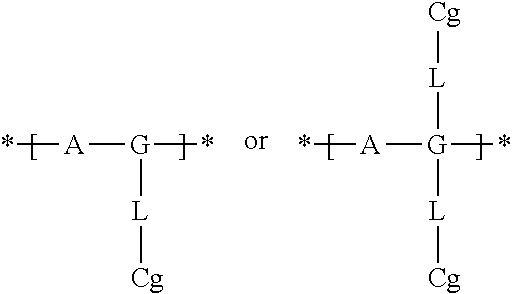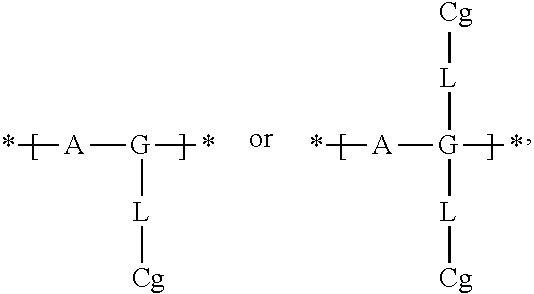Electrochromic films prepared by supramolecular self-assembly
a technology of supramolecular self-assembly and electrochromic film, which is applied in the direction of liquid surface applicators, instruments, coatings, etc., can solve the problems of affecting or negating the desired electrochromic behavior, and the potential disadvantages of using conductive polymers
- Summary
- Abstract
- Description
- Claims
- Application Information
AI Technical Summary
Benefits of technology
Problems solved by technology
Method used
Image
Examples
example 1
Synthesis of Polyiminofluorene-Terpyridine (P-FL-TPY)
[0123]0.060 g (0.185 mmol) 4′-(p-Aminophenyl)-2,2′:6,2″-terpyridine and 0.093 g (0.18 mmol) 2,7-dibromo-9,9-dihexylfluorene are dissolved under inert conditions in 5 ml toluene / dioxane (3:2) using the Schlenk tube technique. To this solution is added 0.005 g Pd2(dba)3, 0.016 g X-Phos and finally 0.054 g (0.56 mmol) sodium t-butoxide. The reaction mixture was filtered under nitrogen at 100° C. for 10 h. After cooling to room temperature the reaction is quenched by the addition of 10 ml aqueous ammonia. The organic phase is diluted with toluene, separated, washed with water several times and then dried over magnesium sulphate. After concentration in vacuo the residue is poured into hexane to precipitate the polymer, which was filtered off, washed with methanol and dried under ambient conditions to yield 0.097 g of the polymer as a lime green powder. 1H-NMR (300 MHz, CDCl3, ppm): δ 8.71 (s, 2H; H3′); 8.69 (d, 2H; H6); 8.64 (d, 2H; H3...
example 2
Synthesis of Polyimino-3,6-Carbazole-Terpyridine (P-3,6-CBZ-TPY)
[0124]0.150 g (0.462 mmol) 4′-(p-Aminophenyl)-2,2′:6,2″-terpyridine and 0.202 g (0.462 mmol) 3,6-dibromo-N-(2-ethylhexyl)carbazole are dissolved under inert conditions in 15 ml dioxane using the Schlenk tube technique. To this solution is added a dioxane solution of 0.010 g (2.5 mol %) Pd2(dba)3 and 0.014 g (15 mol %) tri-tert-butylphosphine, and finally 0.133 g (1.38 mmol) sodium t-butoxide. The reaction mixture is filtered under nitrogen at 100° C. for 10 h. After cooling to room temperature the reaction is quenched by the addition of 10 ml aqueous ammonia. The organic phase is diluted with toluene, separated, washed with water several times and then dried over magnesium sulphate. After concentration in vacuo the residue is poured into hexane to precipitate the polymer, which is filtered off, washed with methanol and dried under ambient conditions to yield. 0.221 g of the polymer as a lime green powder. 1H-NMR (300 MH...
example 3
Synthesis of Polyimino-2,7-Carbazole-Terpyridine (P-2,7-CBZ-TPY)
[0125]0.050 g (0.154 mmol) 4′-(p-Aminophenyl)-2,2′:6,2″-terpyridine and 0.067 g (0.154 mmol) 2,7-dibromo-N-(2-ethylhexyl)carbazole are dissolved under inert conditions in 5 ml toluene using the Schlenk tube technique. To this solution is added a toluene solution of 0.0035 g (3.85 μmol) Pd2(dba)3 and 0.0047 g (0,023 mmol) tri-tert-butylphosphine, and finally 0.044 g (0.462 mmol) sodium t-butoxide. The reaction mixture is filtered under nitrogen at 100° C. for 18 h. After cooling to room temperature the reaction is quenched by the addition of 5 ml water. The organic phase is washed with saturated solution of sodium chloride several times, filtered above celite and then dried over magnesium sulphate. After concentration in vacuo the residue is poured into hexane to precipitate the polymer, which is filtered off, washed with hexane and dried under ambient conditions to yield 0.062 g of the polymer as a yellow green powder. ...
PUM
 Login to View More
Login to View More Abstract
Description
Claims
Application Information
 Login to View More
Login to View More - R&D
- Intellectual Property
- Life Sciences
- Materials
- Tech Scout
- Unparalleled Data Quality
- Higher Quality Content
- 60% Fewer Hallucinations
Browse by: Latest US Patents, China's latest patents, Technical Efficacy Thesaurus, Application Domain, Technology Topic, Popular Technical Reports.
© 2025 PatSnap. All rights reserved.Legal|Privacy policy|Modern Slavery Act Transparency Statement|Sitemap|About US| Contact US: help@patsnap.com



